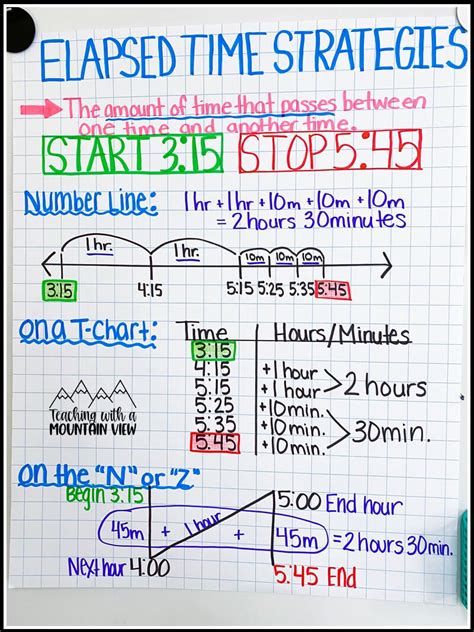How To Teach Elapsed Time
Ronan Farrow
Mar 26, 2025 · 3 min read

Table of Contents
How to Teach Elapsed Time: A Comprehensive Guide for Educators
Teaching elapsed time can be challenging, but with the right approach, you can make it an engaging and understandable concept for your students. This guide provides practical strategies and activities to help your students master elapsed time.
Understanding Elapsed Time
Elapsed time refers to the amount of time that passes between two points in time. It's the difference between a start time and an end time. Before diving into calculations, ensure students understand the basic concepts of time:
- Hours, minutes, and seconds: Review the relationship between these units. Use visual aids like clocks and timers.
- Analog and digital clocks: Students should be comfortable reading both types of clocks. Practice telling time to the nearest minute.
- AM and PM: Explain the difference between these designations and how they relate to the 24-hour day.
Effective Teaching Strategies
Here are some effective strategies to make teaching elapsed time easier and more engaging:
1. Hands-on Activities
Manipulatives: Use clocks with movable hands, number lines, or even counters to represent time visually. Students can physically manipulate these tools to calculate elapsed time, making the concept more concrete.
Real-world examples: Relate elapsed time to their daily routines. For instance:
- "You wake up at 7:00 AM and leave for school at 7:45 AM. How much time did you spend getting ready?"
- "You start watching your favorite show at 3:30 PM and finish at 4:15 PM. How long did the show last?"
2. Visual Aids
Number lines: A number line representing minutes or hours can be incredibly helpful for visualizing elapsed time. Students can jump along the number line to count the minutes or hours.
Clocks and timers: Use physical clocks or interactive online clocks to demonstrate elapsed time visually. Set a timer and have students track the passing of time.
3. Games and Activities
Elapsed Time Bingo: Create Bingo cards with different start and end times. Call out elapsed times, and students mark the corresponding times on their cards.
Time puzzles: Present students with word problems or riddles involving elapsed time. This will encourage problem-solving skills.
4. Breaking Down Complex Problems
For more challenging problems involving different units of time (hours and minutes), encourage students to:
- Break it down: Separate the hours and minutes and calculate the elapsed time for each separately.
- Convert: Convert minutes to hours or vice versa, if necessary, to simplify the calculation.
5. Gradual Progression
Start with simpler problems involving only minutes or hours. Gradually increase the complexity by incorporating both minutes and hours, then potentially even seconds. This gradual progression will ensure a solid foundation.
Addressing Common Challenges
- Difficulty understanding the concept: Use plenty of visual aids and hands-on activities. Relate the concept to their daily lives.
- Struggling with calculations: Provide ample practice problems and break down complex problems into smaller, more manageable parts.
- Confusion with AM/PM: Use visual timelines and real-world examples to help clarify the difference between AM and PM.
By employing these strategies and addressing common challenges proactively, you can effectively teach elapsed time and help your students develop a strong understanding of this essential time-related skill. Remember to make it fun and engaging to keep your students motivated and interested!
Featured Posts
Also read the following articles
| Article Title | Date |
|---|---|
| Liberty How The Revolutionary War Began | Mar 26, 2025 |
| How To Wash Life Jackets In Washing Machine | Mar 26, 2025 |
| How To Use Honey Granules | Mar 26, 2025 |
| How To Turn You Around Manga | Mar 26, 2025 |
| How To Teach Subtraction Kindergarten | Mar 26, 2025 |
Latest Posts
Thank you for visiting our website which covers about How To Teach Elapsed Time . We hope the information provided has been useful to you. Feel free to contact us if you have any questions or need further assistance. See you next time and don't miss to bookmark.
